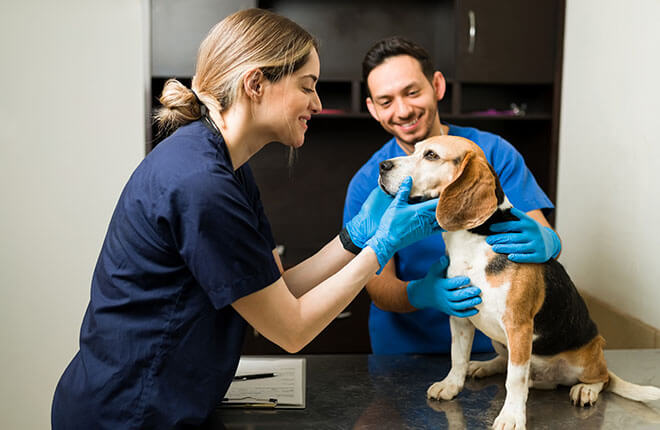The thought of your dog having surgery can create anxiety and fear for any pet owner. But with a bit of education about the reasons different surgeries are recommended (and the steps involved in the procedures themselves), you can feel more comfortable and make better-informed decisions for your dog's health.
Preparing for Your Dog's Surgery
Common dog surgeries generally fall under two categories, elective and urgent/emergency. There are some similar prerequisites for both:
- Your veterinarian needs to know your dog's history.
- Through a physical exam, your veterinarian will evaluate your dog's overall health and check for any issues that may increase risks or that need to be addressed with further care and testing.
- Pre-anesthetic tests such as blood work and radiographs are done.
- You'll discuss the medications used before, during, and after surgery with your veterinarian.
- Your veterinarian will talk through the necessary preparations needed before the surgery, as well as recovery and post-operative care.
- You’ll discuss the possible risks and outcomes of the surgery with your veterinarian.
It's important to know that if a surgery is recommended by your dog's veterinarian, they have the best interest of your dog at heart. All veterinarians want you to ask questions or express any concerns you may have.
What You Should Know About Common Elective Dog Surgeries
Elective surgeries are medically important for the health and longevity of your dog. They are planned since they do not involve a medical emergency. Here are some helpful things to know about elective surgery preparation and pre-operative procedures:
Bathe Your Dog
Typically, following surgery, dogs are not allowed to have a bath for 2 weeks. Grooming your dog prior will make you both feel better.
Fasting
You will need to fast (not feed) your dog the night before surgery so their stomach is empty.
Pre-Operative Procedures
An intravenous catheter is placed for medications and fluids to be administered. Pre-anesthetic drugs will be given to help calm and sedate your dog, as well as control pain. Since these medications can potentially cause nausea and vomiting, dogs are often given medications to help prevent this. Besides making your dog feel better, they help lessen the risk of aspiration pneumonia from vomiting. During the procedure, your dog will be given inhalant anesthesia, kept warm with specialized warming mats, and monitors will be used to evaluate their heart rate, respiratory rate, oxygen levels, etc.
Common Elective Surgeries for Dogs
Spay or Neuter Surgery
The purpose of spay and neuter procedures is to prevent dogs from reproducing. With spays, an incision is made just below the belly button into the abdomen, where the surgeon will remove the ovaries and the uterus. In some cases, only the uterus is removed. With neuters, an incision is made in front of the scrotum. The surgeon will remove both testicles.
Typically, dogs are required to have very limited activity (leash walking only and rest) for 12 to 14 days, after which the incision is usually healed enough for your dog to resume normal activity.
Dental Extractions
This procedure is done by surgically removing loose, broken, fractured, or excessively worn teeth. Typically, dogs are rested for a couple of days following the procedure and fed softened food. The incisions in the mouth heal within 10 to 12 days.
Skin Growths That Are Benign (Non-Cancerous Such As Warts or Moles)
These minor procedures either remove a small section of skin or no skin tissue. If no skin is removed, the area may be treated with topical ointments. Often no rest is needed beyond recovery from anesthesia. When a small piece of skin tissue is removed, a few sutures are placed.
Depending on the location, dogs may not require restrictions on activity. With either process, healing usually takes 10 to 14 days.
What You Should Know About Common Urgent/Emergency Dog Surgeries
Urgent or emergency procedures are those that are medically necessary for your dog’s health and are often lifesaving. You may not have advanced preparations to make in urgent cases like you would with elective surgery. Once your pet is stable, their pain is managed, and their blood tests indicate it is safe to proceed, your veterinarian will perform surgery. Pre-anesthetic medications will be administered to calm them and control nausea and pain. The veterinary team will complete the final pre-op procedures and then begin the surgery.
Common Emergency/Urgent Surgeries for Dogs
Orthopedic Surgeries (Bone Fractures)
These procedures may be performed by your regular veterinarian or a specialist. Depending on the severity, type, and location of the fracture, different types of surgical equipment are required. Some fractures can be repaired with specialized plates and screws, while others will require more extensive measures.
With all orthopedic procedures, strict confinement of 6 to 8 weeks is required, followed by an additional 2 to 4 weeks of slow reintroduction of activity. Due to the risk of infection and pain, antibiotics and pain medications are prescribed. It’s critical to follow all instructions and receive follow-up care to avoid delayed recovery and complications.
Skin Lacerations, Abscesses, or Wounds
In these cases, the area will be thoroughly cleaned, and damaged tissue removed. If possible, the area is then surgically closed with or without a drain (the drain prevents fluid build-up under the skin).
Following your dog's discharge, they must be kept quiet and confined — no running, jumping, or playing. At-home care is required to keep the incision clean. If a drain is present, daily flushing with saline is often required until it is removed 5 to 7 days following the initial surgery. Sutures are removed about 14 days following the surgery.
If the wound cannot be surgically closed, it will require continual bandage changes until the site is healed. Depending on the wound's location and severity, this process may take 4 to 8 weeks. When this situation occurs, it is critical to closely follow your veterinarian's instructions regarding care and activity restriction and keep all appointments for bandage changes.
Open Abdominal Exploratory Surgeries for Intestinal Obstructions
This type of abdominal procedure is done when a foreign object obstructs the gastrointestinal tract. Foreign objects can be located in the stomach, small intestines, large intestines, or in more than one location along the gastrointestinal tract. The resulting blockages can affect blood flow to areas of the intestines, causing them to die and requiring removal. This procedure requires a very large abdominal incision that often runs the entire length of the abdomen. Your dog will generally be hospitalized for several days.
This is critical to be sure there is no leakage from the surgical sites along the gastrointestinal tract and control and maintain your dog's nausea, pain, and hydration.
Following discharge, your dog will need strict confinement with no exercise for 14 days. Leash-controlled walks should be short and for bathroom purposes only — no exercise. If external skin sutures are used, they will be removed about 14 days after the procedure.
Bladder Stone Removal or Urethral Blockages
This procedure is done to remove stones and crystals from the urethra and bladder. A urinary catheter is placed to prevent any stones from going into the urethra. An incision is made in the lower portion of the abdomen. Once the bladder is secured, an incision is made into it, and the stones/crystals are removed. Depending on the size of stones and if crystals are present, the bladder and urethra may be flushed several times to remove smaller stone/crystal material.
Dogs are typically hospitalized for a few days post-op to be sure they are urinating normally and eating and drinking. Once discharged, they need to be strictly confined with no exercise. They must be leash walked to monitor urine color and how much and how often they urinate. Leash-controlled walks should be short and for bathroom purposes only — no exercise. If external skin sutures are used, they will be removed about 14 days after the procedure.
Post-operative Care for Your Dog
For any surgery, you'll be given detailed instructions on feeding, activity, medications, surgical site care, and use of an e-collar (cone) to prevent your dog from licking/chewing their incision. You will receive follow-up calls or be asked to schedule recheck appointments to confirm that your dog's recovery is progressing as it should. It's essential to monitor your dog closely and report anything that may not seem normal.
ZPC-01457R1



